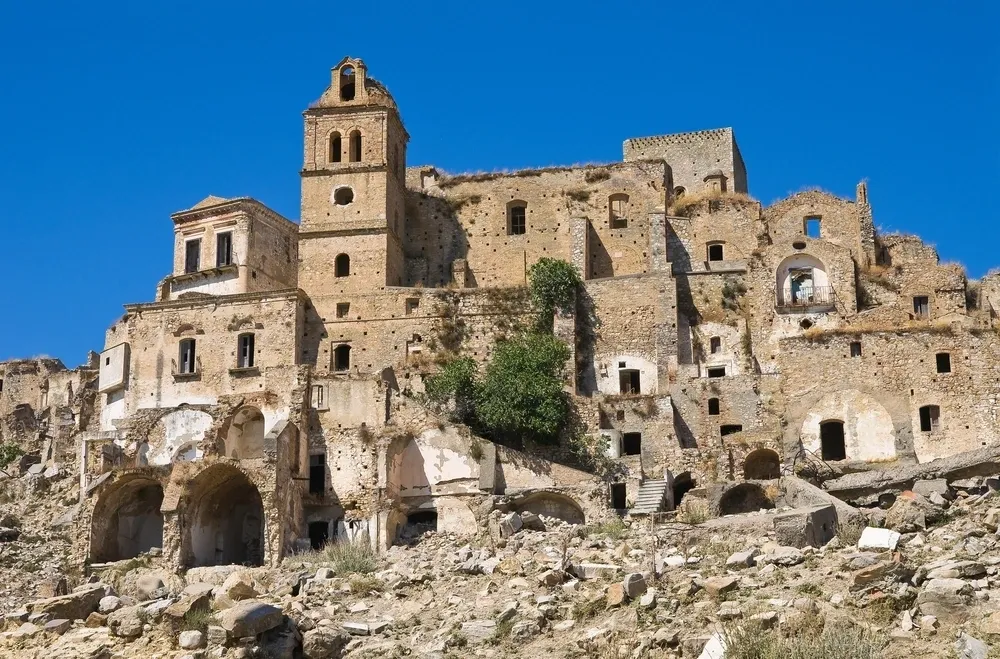Craco, situated in the province of Matera in the southern Italian region of Basilicata, now stands as a haunting ghost town and comune. In the late 20th century, the town faced abandonment due to faulty pipework, believed to have triggered a landslide that forced residents to flee.
This deserted state has transformed Craco into both a tourist attraction and a popular filming location. Recognizing its historical significance, Craco was added to the watch list of the World Monuments Fund in 2010.

Enduring through over 1,400 years of challenges, including the Black Plague and raids by marauding thieves, the residents of Craco were ultimately forced to desert their village in 1991 following a landslide.
History
Given its extensive history, it’s remarkable that natural forces didn’t displace its inhabitants sooner. Established in the 8th century, Craco exhibited remarkable resilience during the tumultuous medieval era. Perched on a cliff 400 meters above the ground, the village commanded panoramic views, rendering its city center easily defensible against potential threats from marauders or invading forces.

Craco boasts a rich and ancient history dating back to the 8th century BC when tombs were first uncovered in the area. Around 540 BC, Ancient Greeks settled in the region, migrating from the coastal town of Metaponto. The town’s name, Graculum, was recorded in 1060 AD by Arnaldo, Archbishop of Tricarico, who described the land as a “little plowed field” in Latin. The close ties between the Church and the town deeply influenced its residents.
Feudal control commenced in 1154 under Eberto, likely of Norman descent, and continued with Roberto of Pietrapertosa in 1179. Craco thrived as a military stronghold under Frederick II, and in 1276, a university was established.
The population steadily grew over the centuries, peaking at 2,590 in 1561. During the 15th century, four grand palaces, including Palazzo Maronna and Palazzo Carbone, were constructed, further embellishing the town’s architectural landscape.

Its Fall
In 1656, Craco was struck by a devastating plague, resulting in a significant loss of life. The townspeople rebelled against the Bourbon feudal system in 1799 during the proclamation of the Parthenopean Republic. However, the republic’s existence was short-lived, as Bourbon forces swiftly quashed the revolution. Craco endured periods of foreign control, including Napoleonic occupation and attacks by brigands in 1807.
By 1815, the town was divided into Torrevecchia and Quarter della Chiesa Madre. Following Italian unification in 1861, Craco faced numerous challenges, leading to mass emigration to North America between 1892 and 1922 due to unfavorable agricultural conditions.
Landslides in 1963, possibly triggered by infrastructure projects, forced the evacuation of Craco, with residents relocating to Craco Peschiera. A flood in 1972 exacerbated the situation, and after the devastating 1980 Irpinia earthquake, the ancient site of Craco was completely abandoned.
In 2007, descendants of Craco emigrants established the “Craco Society” in the United States, dedicated to preserving the culture, traditions, and history of the comune.

Today
Furthermore, a church in Craco serves as the sanctuary for a statue of the Virgin Mary, a remarkable artifact discovered in a nearby body of water.
Although the town remains hauntingly empty due to emigration, life briefly returns during the various religious festivals held in honor of the Virgin Mary and the statue. Craco plays host to six festivals from May to October, offering visitors the opportunity to experience its cultural richness.
Even those arriving during other seasons can still marvel at the charm of the abandoned town and the breathtaking panoramic views of the surrounding area, including the “calanchi,” which are arid and barren mounds beneath the cliffs of Craco.

Please be aware that access to the sites is only available through guided tours. The fees are as follows:
€10 per person for one of the two sites
€15 per person for both sites
An additional €5 per person for an English guide (as of January 2018).

